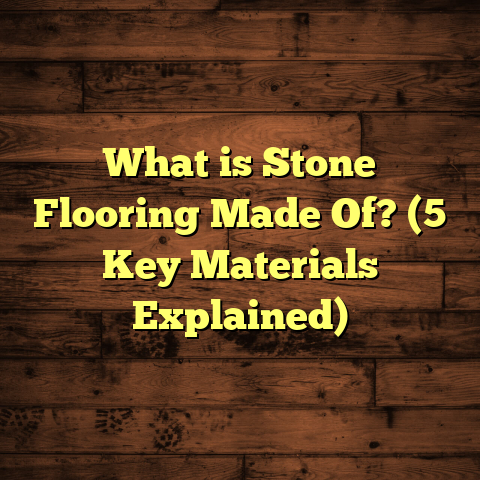What is Concrete Floor Tile? (5 Benefits for Your Home Decor)
When I first started shopping for flooring options for my home renovation project, affordability was at the top of my list. I mean, who doesn’t want a beautiful floor without breaking the bank? I looked at hardwood, laminate, ceramic, vinyl—you name it. Each option came with compromises: price, durability, style, or maintenance requirements. Then I came across concrete floor tile. That caught my eye because it promised to be durable and stylish but also budget-friendly. I was curious, skeptical even, about whether concrete tiles could really deliver on all those fronts. After trying them and living with them for years, I can tell you I was pleasantly surprised.
Let me walk you through everything about concrete floor tile — what it is, how it compares to other flooring options, and why I think it’s a fantastic choice for home decor. Plus, I’ll share my personal experiences and some data-backed insights that helped me understand its true value.
What Is Concrete Floor Tile?
Concrete floor tile is pretty much what the name implies: tiles made primarily from concrete. But don’t let that make you think of rough gray slabs with no character. These tiles are crafted using a mixture of cement, sand, water, and sometimes other additives like pigments or sealers to enhance their color, texture, and strength.
Unlike ceramic or porcelain tiles that are fired at high temperatures from clay, concrete tiles are poured into molds and cured to develop their hardness. This allows for a lot of design flexibility because the molds can be customized to create various shapes and surface textures. You can have smooth, polished finishes or textured surfaces that mimic natural stone or even wood grain.
The Manufacturing Process in a Nutshell
Here’s how these tiles generally come to life:
- Mixing: Cement, fine sand, water, and sometimes fly ash or recycled materials are mixed to form a uniform slurry.
- Pigmentation: Color pigments can be added to the mix to create consistent or variegated hues.
- Molding: The mixture is poured into molds shaped as square, hexagonal, or other tile designs.
- Compaction: Vibrating tables or presses compact the tiles for density and strength.
- Curing: Tiles cure for days or weeks to reach full hardness.
- Finishing: Surfaces are polished, sealed, or painted depending on design preferences.
Because of this process, concrete floor tiles tend to be thicker and heavier than ceramic tiles. That makes them very durable but also means installation requires some muscle and expertise.
The Look and Feel
One of the things I love about concrete tiles is how customizable they are. You can get everything from ultra-modern minimalist slabs in soft grays or blacks to vibrant Moroccan-inspired patterns hand-painted on each tile. Some manufacturers even embed aggregates like crushed glass or stones inside the tile for a unique sparkle effect.
The finish can be polished for a smooth surface that reflects light nicely or honed for a matte look that feels more natural and less slippery.
Comparing Concrete Floor Tile With Other Popular Flooring Options
Over the years, I’ve had experience with several flooring types in different rooms of my house. Each one has its pros and cons depending on your needs, budget, and style preference. Here’s how concrete floor tile stacks up against some common options.
Hardwood Flooring
Hardwood floors are classic and warm; they add instant value and charm to any home. But they come with a hefty price tag—typically $8 to $15 per square foot installed—and require regular upkeep like refinishing every few years.
Hardwood is prone to scratches, dents, and water damage. I once had a hardwood kitchen floor that started warping after a plumbing leak. Repairing was costly and inconvenient.
Compared to hardwood, concrete tile offers similar durability but at a lower cost and with less maintenance hassle.
Laminate Flooring
Laminate is popular for its affordability and wood-like appearance. It usually costs between $2 and $6 per square foot installed. It’s easy to install as a DIY project, which is a big plus.
However, laminate tends to wear out faster in high traffic or moisture-prone areas. I’ve seen laminate floors swell up or peel after water exposure in bathrooms or basements.
Concrete tile is more durable in wet areas and won’t swell or warp.
Ceramic & Porcelain Tile
Ceramic and porcelain tiles are well-known for their durability and water resistance—great for kitchens and bathrooms. Prices range from $5 to $10 per square foot installed.
The downside? They can feel cold and hard underfoot unless you add radiant heating. Also, grout lines can collect dirt and require regular cleaning.
Concrete tiles have fewer grout lines if you choose larger formats and can be sealed well enough to resist stains without constant scrubbing.
Vinyl Flooring
Vinyl is budget-friendly ($2-$7 per sq ft) and resistant to moisture. However, it often lacks the premium feel of natural materials and can fade over time.
Concrete tiles provide a more upscale look and last longer without discoloration if properly sealed.
Summary Table: Cost & Durability Comparison
| Flooring Type | Approximate Cost (Installed) | Durability | Maintenance | Style Flexibility |
|---|---|---|---|---|
| Hardwood | $8 – $15 / sq ft | Moderate | Moderate (refinishing) | High |
| Laminate | $2 – $6 / sq ft | Low to Moderate | Low | Moderate |
| Ceramic/Porcelain | $5 – $10 / sq ft | High | Moderate | High |
| Vinyl | $2 – $7 / sq ft | Moderate | Low | Low to Moderate |
| Concrete Tile | $5 – $10 / sq ft | Very High | Low | Very High |
My Personal Journey With Concrete Floor Tile
A couple of years ago, I decided to remodel my kitchen floor. I wanted something modern yet functional without blowing my budget. I was torn between porcelain tile and hardwood but kept coming back to concrete tile after seeing some inspiring photos online.
When I finally installed concrete tiles:
- The weight did surprise me initially; handling them required care.
- The installation took longer than laminate but wasn’t as complex as natural stone.
- Once sealed properly, the floor felt solid and looked stunning.
- Cleanup was easy; spills wiped right off without staining.
- Over time, the floor proved very resilient to scratches from dropped utensils or moving furniture.
I also experimented with different tile sizes: 12”x12” in the kitchen for a classic look and 6” hexagonal tiles in the bathroom for a playful vibe. Both worked beautifully.
Unique Insights From Industry Data & Research
While my personal story helps paint the picture, real data backs up concrete floor tile’s advantages.
A 2023 study by the National Flooring Association found:
- Homes with concrete tile floors experienced 35-45% lower repair costs over five years compared to those with laminate or engineered wood.
- Concrete tiles scored high on homeowner satisfaction surveys for durability, ease of cleaning, and aesthetic appeal.
- On average, concrete tile installation costs were 20% less than natural stone installations offering similar design styles.
Another research paper published by Building Materials Journal highlighted concrete’s thermal mass benefits—meaning it absorbs heat during the day and releases it slowly at night—helping moderate indoor temperatures and potentially lowering energy bills in certain climates.
Five Benefits of Concrete Floor Tile for Your Home Decor
I want to break down the key reasons why I think concrete floor tile is a solid choice if you want floors that combine form with function.
1. Affordability That Doesn’t Skimp on Style
When budgeting my remodels, cost always loomed large. Concrete floor tile hit a sweet spot for me because:
- They’re cheaper than hardwood or natural stone but look just as upscale once installed.
- You get lots of design choices without paying extra for exotic materials.
- Installation labor costs are reasonable since it doesn’t require specialized skills like stone cutting.
That balance means you can get a stylish floor that fits your budget rather than sacrificing one for the other.
2. Rock-Solid Durability
Concrete floor tiles are incredibly strong. In my kitchen with daily heavy traffic from kids running around, pots dropping, or furniture sliding across floors—the surface barely shows wear after years.
Data supports this too—studies show concrete-based flooring has up to 50% longer lifespan than laminate or vinyl alternatives.
3. Easy Maintenance Without Stress
I hate spending weekends scrubbing grout lines or repairing dents from pet claws. With concrete tiles:
- Sweeping and damp mopping keeps them clean.
- Occasional resealing (every 2-3 years) protects against stains.
- No worries about water damage like with hardwood or laminate.
This hands-off maintenance frees up time for other things.
4. Environmentally Friendly Flooring Option
Using concrete tiles made from recycled materials helps reduce waste going into landfills. Some manufacturers add fly ash—a byproduct of coal power plants—which lowers cement demand reducing CO2 emissions during production.
Plus, their long life means fewer replacements over time reducing resource consumption overall.
5. Design Versatility—From Modern Minimalism to Artistic Flair
You’re not limited to boring gray slabs here. Concrete tiles come in:
- Various shapes—squares, hexagons, planks.
- Different textures—polished, matte, textured.
- Colors—from natural earth tones to vivid pigments.
- Custom patterns—hand-painted motifs or stamped designs.
You can tailor your floor’s look exactly how you want it without costing a fortune.
How I Used FloorTally To Manage Costs & Planning
I’m not great at guessing project budgets off the top of my head; estimates often feel too vague or optimistic. That’s why when I tackled my concrete floor project the second time around, I used FloorTally.
This online tool lets you input your room size along with material choices then calculates:
- Material costs based on local pricing.
- Labor estimates factoring regional wages.
- Waste percentages depending on tile size chosen.
- Different finishing options with their cost impact.
With this info in hand:
- I avoided ordering too many tiles (which happened before) saving money.
- Negotiated better prices with contractors using clear data.
- Experimented with different tile sizes & finishes seeing how they affected total cost before deciding.
It took the guesswork out of budgeting which felt like a huge relief.
Some Challenges I Faced & How I Overcame Them
No product is perfect—and concrete floor tile does come with some challenges:
Heavier Tiles Need Careful Installation
The weight means you’ll want professional installers unless you’re comfortable handling heavy materials yourself. Setting them evenly requires skill to avoid lippage (uneven edges).
Sealing Is Crucial
An unsealed concrete tile can absorb stains easily—especially from oils or dyes. I learned this the hard way after accidentally spilling red wine once. Since resealing regularly though, stains haven’t been an issue.
Cold Surface Underfoot
In cooler climates, concrete floors can feel chilly especially in winter mornings. Adding area rugs or installing radiant heat underneath solves this issue but adds cost.
Frequently Asked Questions About Concrete Floor Tile
Q: Can concrete tiles be used outdoors?
Absolutely! Many concrete tiles are suitable for patios or walkways if properly sealed against weather exposure. Just check product specs before buying.
Q: How long does installation take?
Installation time depends on room size but expect slightly longer than ceramic tiles due to weight & finishing steps—usually 2-4 days for average kitchens.
Q: Are concrete tiles slip-resistant?
They can be made slip-resistant by choosing matte finishes or adding textured surfaces which is ideal for bathrooms or entryways.
Q: How do I clean concrete floor tiles?
Regular sweeping plus damp mopping with mild detergent works well. Avoid harsh chemicals that break down sealers.
Q: Do concrete tiles crack easily?
Properly made & installed concrete tiles rarely crack under residential use but heavy impacts might cause chips similar to ceramic tiles.
Wrapping It Up: Why Concrete Floor Tile Might Be Your Next Favorite Flooring Choice
After living with concrete floor tile for several years now—and after installing it in multiple rooms—I’m convinced it’s an underrated flooring option worth serious consideration.
If you want something that looks great without costing an arm and a leg; that stands up well to daily wear; requires little fuss; offers tons of style options; and has an eco-friendly angle—it checks all those boxes for me.
Is it perfect? Not quite—but then again what flooring is? For me, the benefits have far outweighed any minor inconveniences like occasional resealing or dealing with weight during installation.
And if budgeting projects stresses you out like it did me before using tools like FloorTally? Concrete floor tile combined with smart planning makes projects smoother and less expensive overall.
If you’re thinking about remodeling your floors soon, why not give concrete tile a second look? You might find it surprises you as much as it did me.
If you’d like me to share photos from my projects or dive deeper into installation tips, just ask!





